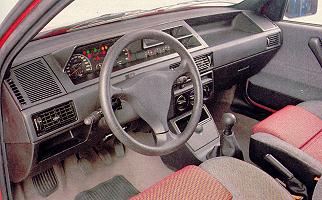At launch the engines comprised three petrol (1.1,
1.4 and 1.6 litre) and two diesel (1.7 and
1.9 turbo) units, all developed specifically for
the new car, and mated to a new 5-speed manual gearbox. Suspension was independent all round, with MacPherson struts at the
front and a trailing arm
arrangement at the rear.
A conventional front disc/rear drum brake setup was joined by an optional Antiskid (as ABS was then known) system from Bosch.
Two trim levels were offered, the base level ('standard' with the 1108, 1372 and 1697 diesel engines) and the 'Digit' (with all engines),
which soon became the DGT. The latters main claim to fame was it's digital instrumentation, the first series production digital dashboard
on a European hatchback, but it also benefitted from electric windows, central locking and various other extras.
November 1989 saw the first 'hot hatch'
in the range, the 1.8ie 16V. Using a 1756cc 16v dohc unit with 136bhp it
was also equipped with disc brakes all round, whilst ABS was optional.
1990 saw more powerplants arrive, a normally aspirated 1929cc diesel unit with 65bhp
and a 1929cc turbodiesel with EGR (with 82bhp) joining the oil-burners,
whilst the petrol range expanded to include 1756cc (109bhp) and 1995cc
(113bhp) units, both with electronic fuel injection and the latter also
with a three-way catalytic converter. The 1372cc and 1581cc engines also
increased in power to 76bhp and 84bhp respectively. The catalysed 1600
adopted the 1581cc sohc unit with 77bhp, replacing the 1585cc dohc catalysed
unit. The transmission options also broadened with the arrival of the Tipo
Selecta, using a CVT. This was available with either a 1372cc or 1581cc engine.
Slightly later, in September of the same year, the 1.8ie 16v was dropped
from the range, being made redundant by the new 2-litre unit. In that month, at the Frankfurt Motorshow, the entire range was
mildly tweaked, mainly regarding the badging. The base and DGT were replaced
by the standard (the old base), S (electric windows, central locking) and
SX (the old DGT plus power steering) trim levels.
The second series of the Tipo arrived in
1993. A major overhaul of the product was most immediately recogniseable by its new grille.
The main changes were concentrated on improving the safety of the car, with a heavily
revised structure including side impact bars, deformable zones,
height adjustable seatbelts, seatbelt pre-tensioners, energy absorbing steering wheel, airbags etc. The most interesting
evolution for car enthusiasts was the addition of a three-door body style. In total, as well as the two body styles, 8 engines and 3 transmissions, it
was available in 5 trim levels (S, SX, SLX, GT and 16v).
Mechanically, all the engines were catalysed (except the diesels), the range comprising the 1.4ie
(1372cc sohc with 71bhp), 1.6ie (1581cc sohc with 76bhp), 1.8ie (1756cc
dohc with 105bhp), 2.0ie (1995cc dohc with 115bhp), 2.0ie 16V (1995cc dohc
with 142bhp), 1.7D (1697cc sohc with 58bhp), 1.9D (1929cc sohc with 65bhp) & 1.9 D GT (1929cc sohc
turbo with 92bhp). Alongside the conventional manual 5-speed transmission a CVT (Continuously Variable Transmission) and a 4-speed
automatic were available (the former with the 1.6 engine, the latter with the 2.0).
Production continued until 1995, when it
was replaced by the Bravo/Brava pair. The Tipo
floorpan proved a highly successful design, also being used in the Tempra
(basically a Tipo saloon), the
Coupé, the Alfa
Romeo 155 and the Lancia Dedra.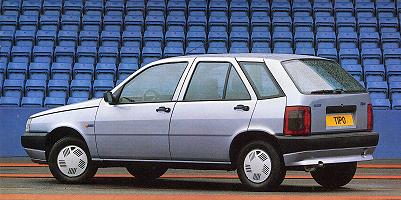 The Tipo was first revealed to the public in January 1988. An all new design
to replace the Strada/Ritmo it was initially
available with only one body style - a five door with a drag coefficient
of 0.31. It won the Car of the Year award in 1989 and was greatly praised
for it's class leading interior space (especially the boot), accessibility, handling and drivability. The styling was rather less conventional, but
was accepted as a step in a new direction, designed to be compact, aerodynamic and roomy inside with excellent visibility.
Safety, with optimisation of the deformation in the event of an accident, and durability, all external parts were galvanised (over 70% of the entire bodyshell)
also featured highly on the agenda.
The Tipo was first revealed to the public in January 1988. An all new design
to replace the Strada/Ritmo it was initially
available with only one body style - a five door with a drag coefficient
of 0.31. It won the Car of the Year award in 1989 and was greatly praised
for it's class leading interior space (especially the boot), accessibility, handling and drivability. The styling was rather less conventional, but
was accepted as a step in a new direction, designed to be compact, aerodynamic and roomy inside with excellent visibility.
Safety, with optimisation of the deformation in the event of an accident, and durability, all external parts were galvanised (over 70% of the entire bodyshell)
also featured highly on the agenda.
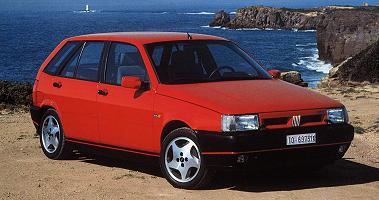 Production was at the Cassino factory, with the assembly line significantly rebuilt and automated for the Tipo, with over 403 robots in the Tipo bodyshop (welding, holding, fastening, priming, painting, testing)
alone, monitored by 49 video cameras. The plant also contains 1720 AGVs (Automatically guided vehicles) !
Production was at the Cassino factory, with the assembly line significantly rebuilt and automated for the Tipo, with over 403 robots in the Tipo bodyshop (welding, holding, fastening, priming, painting, testing)
alone, monitored by 49 video cameras. The plant also contains 1720 AGVs (Automatically guided vehicles) !
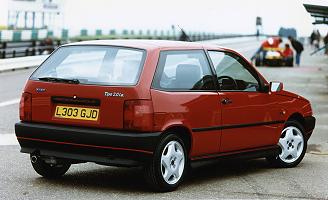 The Geneva show of 1991 saw a new model at the top of the Tipo range, the 2.0ie
16v (or 'Sedicivalvole') complete with environmentally friendly catalytic converter and EGR system.
The heart of the new version, the engine, was a 16v version of the twin-cam unit in
the 2.0ie car, in this installation producing 148bhp. The new car also featured uprated brakes, an optimised chassis, bigger alloy wheels etc. Rave reviews in the
press followed, and the car was universally praised.
The Geneva show of 1991 saw a new model at the top of the Tipo range, the 2.0ie
16v (or 'Sedicivalvole') complete with environmentally friendly catalytic converter and EGR system.
The heart of the new version, the engine, was a 16v version of the twin-cam unit in
the 2.0ie car, in this installation producing 148bhp. The new car also featured uprated brakes, an optimised chassis, bigger alloy wheels etc. Rave reviews in the
press followed, and the car was universally praised.
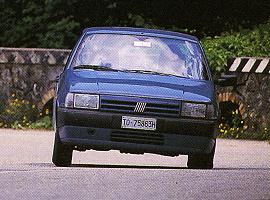 |
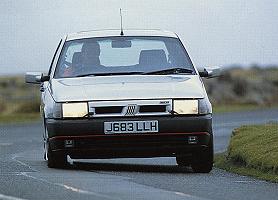 |
Technical Details
| Driveline | transverse engine at front with front wheel drive |
| Engines |
At launch :
1108cc (70x72mm) 4 cylinder sohc carburettor with 56bhp @ 5,500rpm (image) 1372cc (80.5x67.4mm) 4 cylinder sohc carburettor with 72bhp @ 6,000rpm (image) 1581cc (86.4x67.4mm) 4 cylinder sohc carburettor with 83bhp @ 6,000rpm 1697cc (82.6x79.2mm) 4 cylinder sohc diesel with 58bhp @ 4,600rpm 1929cc (82.6x90mm) 4 cylinder sohc turbocharged diesel with 92bhp @ 4,100rpm (image) 1993 range : 1372cc (80.5x67.4mm) 4 cylinder sohc SPI with 71bhp @ 6,000rpm 1581cc (86.4x67.4mm) 4 cylinder sohc SPI with 76bhp @ 6,000rpm 1756cc (84x79.2mm) 4 cylinder dohc MPI with 105bhp @ 6,000rpm (image) 1995cc (84x90mm) 4 cylinder dohc MPI with 115bhp @ 5,750rpm 1995cc (84x90mm) 4 cylinder 16v dohc MPI with 142bhp @ 6,000rpm 1697cc (82.6x79.2mm) 4 cylinder sohc diesel with 58bhp @ 4,600rpm 1929cc (82.6x90mm) 4 cylinder sohc diesel with 65bhp @ 4,600rpm 1929cc (82.6x90mm) 4 cylinder sohc turbocharged diesel with 92bhp @ 4,100rpm |
| Suspension | front
: MacPherson strut with telescopic dampers and coil springs plus anti-roll
bar
rear : independent with telescopic dampers and coil springs plus anti-roll bar wheelbase : 2540mm front track : 1436mm (1.8ie, 2.0ie & 16V : 1445mm) rear track : 1415mm (1.8ie, 2.0ie & 16V : 1421mm) |
| Brakes | front : discs (240mm, 257mm or 284mm ventilated depending on engine)
rear : drums (180mm or 228mm) (240mm discs on 'sporting' versions) handbrake operating on the rear via a cable |
| Gearbox | 5 speed manual
4 speed automatic CVT cable or hydraulic clutch actuation depending on model |
| Steering | Rack and pinion (hydraulically power assisted on some models)
3 turns lock to lock |
| Empty weight | 1100 : 950kg; 1400 : 990kg; 1600 : 1000kg
1.7D : 1050kg; 1.9TD : 1660kg 1.8ie : 1110kg; 2.0ie : 1150kg 1.8 ie 16V : 1100kg; 2.0ie 16V : 1180kg |
| Dimensions | click here. |
Here there is a diagram illustrating the structure
of the three-door Tipo
Performance
Tuning
There are three main areas to concentrate
on, the engine (and transmission), the brakes and the suspension and then
various other details. These three should be done together since they complement
each other, not all of one and none of another !
1. The engine.
Before modifying the engine it is worthwhile
filling it with a good quality synthetic oil and fitting new spark plugs.
An engine oil additive may also be used.
For single cam engines:
For twin cam carburettored engines:
For fuel injected engines:
Other things to do on all engines should
include fitting a cold air intake, a large diameter pipe (minimum 5cm)
to provide air from outside the engine bay to the air filter. The exhaust
manifold can also be lagged with thermal cloth or tape to keep the exhaust
gases hotter (and thus reduce back pressure) and also to keep the underbonnet
(and hence intake and fuel) temperatures lower.
After modifying the engine it may be worth
fitting an oil cooler (depending on the level of modification carried out).
If overheating is a problem due to the increased power output then a small
hole can also be drilled through the plate in the thermostat.
Regarding the transmission the main requirement
is to uprate the clutch to handle the increase in power and torque achieved
though the engine modifications. Friction plates can be purchased with
improved materials and heavier duty pressure plates are also available.
Whilst doing this it is worthwhile lightening the flywheel. 2. The brakes.
Initially it is relatively easy to replace
the brake discs with drilled and grooved items, and the pads for a harder
compound. The latter should not be too hard (ie no race pads on the road)
or they will not function effectively at the normal 'road' operating temperatures.
Stainless steel braided flexible hoses will improve the pedal feel and
reduce the chance of damage whilst DoT5 fluid (not silicon) will increase
the temperature at which it can operate effectively. If the brakes are
getting too hot the dustguards can be removed and/or ducts fitted, taking
air from behind the front bumper.
If more serious braking is required the
next modification would be to increase the disc size. The easiest route
(for the smaller engined models) is to use the brakes from the quicker
Tipo's (ie 16V); both the discs at the front and rear. For the 16V, and
others if required, it is possible to use larger discs with a bracket allowing
use of the production callipers, or alloy four pot callipers can be fitted.
In order to improve the balance of the
car under braking it is desireable to be able to adjust the balance of
braking from front to rear (and vice versa). This can be accomplished by
fitting a bias valve in the line to the rear brakes, usually in a position
so that it can be reached from the drivers seat. 3. The suspension.
The easiest improvement,and the one which
will probably bring the single most noticeable change, is to replace the
full set of dampers and springs. A variety of kits are available which
include four matched dampers and springs. Top adjustable units are There are then two other main suspension
aims; to reduce the flexiblity in the suspension and to increase the stiffness
of the car, both of which aim at more accurate control of the wheel movement.
To reduce the flexibility it is possible to fit nylon bushes instead of
the normal production rubber items, or if perfection is desired the suspension
can be fitted with metallic bearings (rose joints / rod ends). Spherical
bearing top mounts can also be used. To stiffen the car it is most popular
to fit strut braces. These can be fitted to the front and rear. For more
extreme cases a rollcage can be fitted.....
Into this category also fall the choice
of wheels and tyres. With an increase in power it can be necessary to fit
larger tyres (thus requiring larger wheels) but the temptation to fit the
biggest possible should be resisted. Consideration should be given to fitting
a wider tyre on the front (since they provide traction and steering) but
keeping the standard, or a wider but not as wide as the front, tyre at
the rear. This will improve the balance of the car. 4. other things.
Other modifications worth considering include
fitment of a shift light (and rev limiter if there is not one as standard),
higher power bulbs in the headlights (if you are going to go faster you
need to see further) and installation of a quicker steering rack.
Buying / Selling
The most desireable model is the Seidicivalvole,
but the more mundane models offer a roomy, reliable and usually cheap form
of transport, with Italian character thrown in.
Some tips to do before selling :
(they may seem obvious, but most people don't do them and thus are in a weaker bargaining position)
Tidy inside the car thoroughly : hoover
the floor, empty all pockets, ashtrays (wash), glove compartment etc...,
wipe the trim with a damp cloth, give the cockpit a good airing to get
rid of any odours ! Reset the trip meter to 00000 - it is a pleasant (subconcious) surprise.
If the car has been standing give it a
good run - this will clear out the engine (reduce exhaust smoke), put a
shine on the brake discs and loosen up any joints that may otherwise make some noises.
'Back to black' products are very effective
at temporarily restoring bumpers and trim. This makes a big difference
to any car. Do it a week before you expect people to view the car, otherwise
it may be a bit too obvious !
Jetwash under the car, especially under
the engine and in the wheelarches. The prospective buyer may be an enthusiast,
and this makes it easier for them to see what they want to check.
Obviously wash the car and clean the windows !
If you are going to buy a car always check the following :
The bodywork should not be a major issue,
but check around just in case. The wheelarches, suspension and engine mounts,
sills, door pillars, scuttle panel and the floor can be easily inspected.
If a sunroof is fitted check around the edge. Check that there are no mismatching
panels, large areas of discolouration or signs of fresh paint.
Check for a damp carpet or the presence
of mould - if the carpet is damp then the floor is almost certainly corroded
- whatever the age of the car.
Check the brake pedal does not go to the
floor if pressed hard for a long time and check the gearchange for clean engagement.
The engine should be run up to temperature,
check the exhaust for smoke, the condition of the breather (look for mayonaise),
the condition of the oil filler cap (again white deposits can indicate head
gasket or other serious problems) and the colour of the coolant (preferably
not brown!). If the car has an oil pressure guage this should not drop
below 1 bar at idle, and should be around 3 to 4 bar at speed. Listen to
the noise of the engine, then depress the clutch and engage first gear.
Whatever noise has disappeared was coming form the gearbox, what remains
is from the engine. Also check the condition of the engine oil on the dipstick.The
lighter brown the better, if it is thick black then leave quickly.
Check tyre wear, uneven patterns could imply a bent chassis.
Always take it for a test drive. Check
that the car tracks in a straight line with no steering input. Find a large
open area and complete several lock to lock turns(also in reverse), listening
for any noises. Try the handbrake when moving - seized rear callipers will
mean uneven braking or no braking.
Generally, Fiat Tipo's are mechanically
pretty good, and the old Italian problem of rust had been overcome before the Tipo arrived.
Links
A private Fiat Tipo 16V website
An excellent Tipo 16V website
A German Tipo website
Fiat Tipo Workshop Manual :
buy it online here (in association with
Amazon)
For more books on Fiats, see our Online Bookstore
Tipo comment form
Your Comments
The fiat tipo 1372 formula
has been an excellent car. it has been very reliable and fairly economicle
i would recomend to all ages. (dizzy dave)
I have had 2 sedicivalvoles,
and they will blow any other hot hatch away, with the greatest of
ease, and noise. Not enough headroom though, and the clocks a bit whiney.
The Fiat Tipo is an excellent
car ,it never visit the mecanic and wants always more speed. I recomend
to test one, pure adrenaline.(Alex, Argentina)
I'm from Turkey and I have
a Tipo 1.4 S which was produced in Turkey. I've been driving it for a year
and I am quite happy with it. I have to mention that even if the engine
is 1400cc it is quite powerful. Also fuel consumption is considerably low.
I never felt it necessary to add oil between oil changes which is very
remarkable. The space inside the car is very large and there is nearly
no dead zone of view. The only weak point of the car is the front suspension
which is very gentle. Off road driving can be quite expensive.
Hello, i just wanted to tell
you about my 90. tipo 1,4. It has now got 363000. km at the meter vithout
problems! The only things i have had to replace is the generator and the
waterpump. I love my tipo!
Hi, I have a 1600 DOHC '89
and is enought reliable in long-term and also spacious. Only disadvantages
I found: more engine power starts around 3500 rpm and consumption. Maybe
Tipo II was improved. The most elegant choice from cars from begin of 90years.
I like Tipo! (Pavel, CZ)
I have an '88 Tipo 1.6 dgt
and I'm in love with the beast, 182000 km and still as good as the first
day, definitely the choice if you wanted to be a bit different from the
rest. I find great pleasure when I manage to blow a BMW away on a mountain
road, but the pleasure is bigger if it is a Golf tdi :) only criticism:
brakes. Tipo=love. (Calimero, Spain)
I've got a 1991 Tipo DGT.
I've fitted a K&N air Filter and special spark plugs. It has now, with
the original carburettor a double body webber, about 80 CV.
I've a 1990 Tipo 1.8 i.e.,
it now has 210000 km and nothing has been changed on that car (exept oil,
tyre, brake pad), no rust (I wash it every 6 month), average consumption
8l/100km. This car is quite powerfull (110 bhp) and I can reach the 200
km/h. I can tell you that the TDI golf (even the 115 bhp) have very hard
job to follow this car !. I had a lot of Fiat (127,Ritmo, Cinquecento,
Bravo) they were or still are (Bravo) very good and reliable but the Tipo
is realy the best car I never had and I will be very sad when I'll have
to get rid of it (for now, there is no reason). Ben (Belgium)
Hi I have a 1991 Fiat Tipo
dgt. Its a great car and its definately not slow and its got all the bits
you could want, power windows, central locking, alarm immobilizer, power
steering, alloy wheels and I just love the car. Its great.
I own my Tipo since 1989; its best things are the engine and the gearbox .
It's extraordinary between 200 and 4500 rpm(1400cc. engine) and I only changed the clutch once! I won' t change it! (Willamovitz, Italy)
185.000 km, 12 years. My 1.6 DGT Tipo has never vissited a workshop for serious damages.
Now I've changed the spark plugs, the air and the oil filters, cleaned the carburator,... and it runs very well. I like the car, bat I'd like chage my 13" inch.
wheels for the 14" inch. Abarth alloy wheels. I think the front is too heavy because of the engine, and you have to be very careful with wet
pavements in mountain roads. In the other hand, I've never have had problems with the brakes, excepting the hand brake, which cannot
support the car if you park it in big descents. Also I changed once the waterpump, and twice one of the central locking motors.
The interior is fine at the moment; in any case, I've seen a Polo VW with 12000 km and the tapestry was very damaged.
My Tipo is much more old and the tapestry is fine.
Tough engine, fine until 3000 rpm, beasty from 3800 rpm. 3000-3800?? oh, black hole. The best of the 1600 carburated engine is over
4000 rpm until 5200 rpm.
I have an 1990 tipo 1.9 TD .It is very confortable and spacious.During all winter motor start runing at first
attempt.It is very economikal 5,5 l / 100km ( 90km/h).I only change breaking pads,oils,filters,tires.Motor is still
original (no change of spare parts).Digital board now showing 400 000 km. (Slavo, Slovakia)
I've had my 1.6 DGT for over 5 years, and it is so reliable that I sometimes take it for granted as i ask it to
do things it really shouldn't do. But it does them anyway - like towing my classic fiats around, and acting as a
dump truck, or removal van due to the massive space inside. But the Tipo's at it's best when up against far
newer japanese multivalve engined cars on winding roads - oh that handling! It's no coincidence the floorpan was used on other models! (Grant, NZ)
I had a Tipo 1.6 ie DGT from 1989. The car was just great, a lot of space, and very drivable. (Bojan, Republic Srpska)
I have had a blue 89 Tipo 1.6 DGT for 2 years and use it everyday for my 120 mile round trip to work in all weathers. Only cost £600.
No problems and it starts first time and now has 120000 miles on the digi dash, but sadly needs welding underneath to keep legal. A brilliant fun car and I would have another tomorrow.(Neil, UK)
I have a Fiat Tipo 1.6dgt and its a great car its been fitted with 14" wheels from a Fiat Bravo and ive put in the front fogs (these just make it look so much better)as for the engine its great definatley not slow. al the electrics work Ive had to
change minor things central locking moters wiper motors but it mechanically pretty good definately
recommend this car to any one and the dash on the dgt always gets looks from people at night as it glows. (Ray, UK)
I have a 1996 sx i.e., is an excellent car, very fast and handle. I beat every modern cars in many times. I love Tipo I had a 94 SX
carburator and now a 96 SX IE. Its a great car. Never has a mechanical problem. (Gonzalo, Argentina)
There is also a list of all our picture galleries (including museums,
motorshows and various events).
Wallpapers/Desktop Backgrounds of numerous Fiats also available to download.
Use
the buttons at the top to navigate further, or
Copyright © 2000 to 2008 CarsfromItaly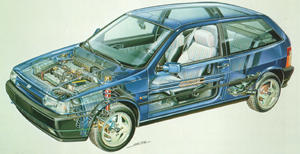
model
max speed
0-100kp/h
standing km
braking from 100km/h
Tipo 1.8ie (1989)
205 km/h
9.4 sec
30.5 sec
46.1 m
The first improvements are relatively
simple. The air filter can be replaced for an aftermarket item which will
help the engine breathe more freely, the type which completely replace
the original airbox are best, and the exhaust can be replaced for one which
will restrict the exit of the gases less. The whole system should be replaced,
not just the rear section.
Improving the fuelling is the biggest
change without opening the engine. A pair of downdraught or sidedraught
carburettors(about 40 in size) will provide adequate air-fuel mixture and
should also mprove the throttle response. An improved camshaft will also
reap big 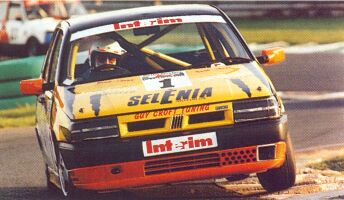 benefits,especially
when combined with the carburettors.
benefits,especially
when combined with the carburettors.
Again the approach of using a pair of
twin carburettors and a camshaft is the best way to wring more power from
these engines, after which work should centre on machining the cylinder head.
The most effective modification (short
of engine rebuilds!) is probably to replace the electronic control unit
(or 'chip'). A variety of these are available, but all should increase
the power and improve the driveability. For Tipo's the number of 'off-the-shelf'
units is limited, but it is possible to buy a unit which can be programmed
to any car and this will fulfill the role nicely.
The high tension leads can also be replaced with performance ones.
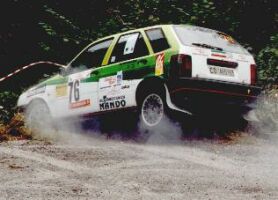 compromised,
but are good for road and track day cars since it allows the suspension
to be adjusted between these two, rather different, requirements. Coil
over units add more adjustability and can be purchased outright, or can
be made from standard dampers by welding a threaded sleeve to the standard tube.
compromised,
but are good for road and track day cars since it allows the suspension
to be adjusted between these two, rather different, requirements. Coil
over units add more adjustability and can be purchased outright, or can
be made from standard dampers by welding a threaded sleeve to the standard tube.
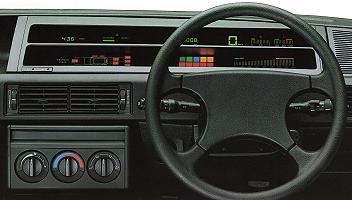 Check
the main electrical functions - wipers, windows, etc... try putting the
main beam and wipers on at the same time. Check the headlight reflectors for rust.
Check
the main electrical functions - wipers, windows, etc... try putting the
main beam and wipers on at the same time. Check the headlight reflectors for rust.
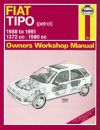 Fiat
Tipo ('88 to '91)
Fiat
Tipo ('88 to '91)Haynes, 1989
Fiat
Tipo & Tempra : Repair Manual & Service Guide
Porter, 1998
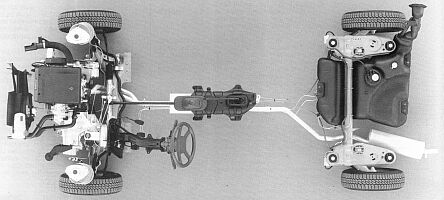 The
Fiat Tipo is a very good car but is very delicate in off road the tipo
1600 is very heavy for the engine and the tune up is very complicated without
scanner tank yow ( c o n d o r m a n )
The
Fiat Tipo is a very good car but is very delicate in off road the tipo
1600 is very heavy for the engine and the tune up is very complicated without
scanner tank yow ( c o n d o r m a n )
In highway it can reach
200 Kph (don´t say that to my girlfriend). About maintenance, it's
me who does all the work. I love FIATs.
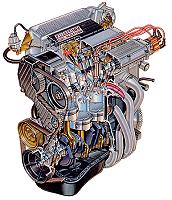 Bored with my old 318i, i bought a '91 DGT 1.6. Although not as
refined as the Germans, the Tipo is lighter and far more fun. Made for the
open road. Handles beautifully with just a little understeer. Build quality
OK, everything still works properly (Blaupunkt hasn't got long though),
engineering has a Toyota quality to it. Fresh, original styling - entire
rear gorgeous, and door mirrors particularly well done. Huge interior, love
the dash. Reliable. Ride quality at low speed is poor but aprt from that -
Tipo is a cool car. Lent my BMW to a friend - he can keep it.
(Scotty, NZ)
Bored with my old 318i, i bought a '91 DGT 1.6. Although not as
refined as the Germans, the Tipo is lighter and far more fun. Made for the
open road. Handles beautifully with just a little understeer. Build quality
OK, everything still works properly (Blaupunkt hasn't got long though),
engineering has a Toyota quality to it. Fresh, original styling - entire
rear gorgeous, and door mirrors particularly well done. Huge interior, love
the dash. Reliable. Ride quality at low speed is poor but aprt from that -
Tipo is a cool car. Lent my BMW to a friend - he can keep it.
(Scotty, NZ)
